My ultimate goal is to render 1 million spheres of different sizes and colors at 60 fps. I want to be able to move the camera around the screen as well.
I have modified the code on this page of the tutorial I am studying to try to instance 1 million cubes. I have been able to instance up to 90,000 cubes, but if I try to instance 160,000 cubes then the program breaks. I get an error that the program has "stopped working" and unexpectedly quit. I don't know what kind of error this is, but I believe that it may be memory related.
My understanding of instancing is naive, so I do not know what the problem is. I believe that instancing 1 million cubes is the next step to my goal of instancing 1 million spheres. So, my question: How do I instance 1 million cubes/objects in OpenGL?
I have been learning OpenGL through this tutorial and so I use 32-bit GLEW and 32-bit GLFW in Visual Studio 2013. I have 8 GB of RAM on a 64-bit operating system (Windows 7) with an 2.30 GHz CPU.
My code is below:
(set line #2 to be the number of cubes to be instanced. Make sure line#2 has a whole-number square root)
// Make sure NUM_INS is a square number
#define NUM_INS 9
// GLEW
#define GLEW_STATIC
#include <GL/glew.h>
// GLFW
#include <GLFW/glfw3.h>
// GL includes
#include "Shader.h"
// GLM Mathemtics
#include <glm/glm.hpp>
#include <glm/gtc/matrix_transform.hpp>
#include <glm/gtc/type_ptr.hpp>
// Properties
GLuint screenWidth = 800, screenHeight = 600;
// Function prototypes
void key_callback(GLFWwindow* window, int key, int scancode, int action, int mode);
// The MAIN function, from here we start our application and run the Game loop
int main()
{
// Init GLFW
glfwInit();
glfwWindowHint(GLFW_CONTEXT_VERSION_MAJOR, 3);
glfwWindowHint(GLFW_CONTEXT_VERSION_MINOR, 3);
glfwWindowHint(GLFW_OPENGL_PROFILE, GLFW_OPENGL_CORE_PROFILE);
glfwWindowHint(GLFW_RESIZABLE, GL_FALSE);
GLFWwindow* window = glfwCreateWindow(screenWidth, screenHeight, "LearnOpenGL", nullptr, nullptr); // Windowed
glfwMakeContextCurrent(window);
// Set the required callback functions
glfwSetKeyCallback(window, key_callback);
// Initialize GLEW to setup the OpenGL Function pointers
glewExperimental = GL_TRUE;
glewInit();
// Define the viewport dimensions
glViewport(0, 0, screenWidth, screenHeight);
// Setup OpenGL options
//glEnable(GL_DEPTH_TEST);
// Setup and compile our shader(s)
Shader shader("core.vs", "core.frag");
// Generate a list of 100 quad locations/translation-vectors
glm::vec2 translations[NUM_INS];
int index = 0;
GLfloat offset = 1.0f/sqrt(NUM_INS);
for (GLint y = -sqrt(NUM_INS); y < sqrt(NUM_INS); y += 2)
{
for (GLint x = -sqrt(NUM_INS); x < sqrt(NUM_INS); x += 2)
{
glm::vec2 translation;
translation.x = (GLfloat)x / sqrt(NUM_INS) + offset;
translation.y = (GLfloat)y / sqrt(NUM_INS) + offset;
translations[index++] = translation;
}
}
// Store instance data in an array buffer
GLuint instanceVBO;
glGenBuffers(1, &instanceVBO);
glBindBuffer(GL_ARRAY_BUFFER, instanceVBO);
glBufferData(GL_ARRAY_BUFFER, sizeof(glm::vec2) * NUM_INS, &translations[0], GL_STATIC_DRAW);
glBindBuffer(GL_ARRAY_BUFFER, 0);
// Generate quad VAO
GLfloat quadVertices[] = {
// Positions // Colors
-0.05f, 0.05f, 1.0f, 0.0f, 0.0f,
0.05f, -0.05f, 0.0f, 1.0f, 0.0f,
-0.05f, -0.05f, 0.0f, 0.0f, 1.0f,
-0.05f, 0.05f, 1.0f, 0.0f, 0.0f,
0.05f, -0.05f, 0.0f, 1.0f, 0.0f,
0.05f, 0.05f, 0.0f, 0.0f, 1.0f
};
GLfloat vertices[] = {
-0.5f/sqrt(NUM_INS), -0.5f/sqrt(NUM_INS), -0.5f/sqrt(NUM_INS), 1.0f, 0.0f, 0.0f,
0.5f/sqrt(NUM_INS), -0.5f/sqrt(NUM_INS), -0.5f/sqrt(NUM_INS), 1.0f, 0.0f, 0.0f,
0.5f/sqrt(NUM_INS), 0.5f/sqrt(NUM_INS), -0.5f/sqrt(NUM_INS), 1.0f, 1.0f, 0.0f,
0.5f/sqrt(NUM_INS), 0.5f/sqrt(NUM_INS), -0.5f/sqrt(NUM_INS), 1.0f, 1.0f, 0.0f,
-0.5f/sqrt(NUM_INS), 0.5f/sqrt(NUM_INS), -0.5f/sqrt(NUM_INS), 0.0f, 1.0f, 0.0f,
-0.5f/sqrt(NUM_INS), -0.5f/sqrt(NUM_INS), -0.5f/sqrt(NUM_INS), 0.0f, 0.0f, 1.0f,
-0.5f/sqrt(NUM_INS), -0.5f/sqrt(NUM_INS), 0.5f/sqrt(NUM_INS), 0.0f, 0.0f, 1.0f,
0.5f/sqrt(NUM_INS), -0.5f/sqrt(NUM_INS), 0.5f/sqrt(NUM_INS), 1.0f, 0.0f, 0.0f,
0.5f/sqrt(NUM_INS), 0.5f/sqrt(NUM_INS), 0.5f/sqrt(NUM_INS), 1.0f, 1.0f, 0.0f,
0.5f/sqrt(NUM_INS), 0.5f/sqrt(NUM_INS), 0.5f/sqrt(NUM_INS), 1.0f, 1.0f, 0.0f,
-0.5f/sqrt(NUM_INS), 0.5f/sqrt(NUM_INS), 0.5f/sqrt(NUM_INS), 0.0f, 1.0f, 0.0f,
-0.5f/sqrt(NUM_INS), -0.5f/sqrt(NUM_INS), 0.5f/sqrt(NUM_INS), 0.0f, 0.0f, 1.0f,
-0.5f/sqrt(NUM_INS), 0.5f/sqrt(NUM_INS), 0.5f/sqrt(NUM_INS), 1.0f, 0.0f, 0.0f,
-0.5f/sqrt(NUM_INS), 0.5f/sqrt(NUM_INS), -0.5f/sqrt(NUM_INS), 1.0f, 1.0f, 0.0f,
-0.5f/sqrt(NUM_INS), -0.5f/sqrt(NUM_INS), -0.5f/sqrt(NUM_INS), 0.0f, 1.0f, 0.0f,
-0.5f/sqrt(NUM_INS), -0.5f/sqrt(NUM_INS), -0.5f/sqrt(NUM_INS), 0.0f, 1.0f, 0.0f,
-0.5f/sqrt(NUM_INS), -0.5f/sqrt(NUM_INS), 0.5f/sqrt(NUM_INS), 0.0f, 0.0f, 0.0f,
-0.5f/sqrt(NUM_INS), 0.5f/sqrt(NUM_INS), 0.5f/sqrt(NUM_INS), 1.0f, 0.0f, 0.0f,
0.5f/sqrt(NUM_INS), 0.5f/sqrt(NUM_INS), 0.5f/sqrt(NUM_INS), 1.0f, 0.0f, 0.0f,
0.5f/sqrt(NUM_INS), 0.5f/sqrt(NUM_INS), -0.5f/sqrt(NUM_INS), 1.0f, 1.0f, 0.0f,
0.5f/sqrt(NUM_INS), -0.5f/sqrt(NUM_INS), -0.5f/sqrt(NUM_INS), 0.0f, 1.0f, 0.0f,
0.5f/sqrt(NUM_INS), -0.5f/sqrt(NUM_INS), -0.5f/sqrt(NUM_INS), 0.0f, 1.0f, 0.0f,
0.5f/sqrt(NUM_INS), -0.5f/sqrt(NUM_INS), 0.5f/sqrt(NUM_INS), 0.0f, 0.0f, 0.0f,
0.5f/sqrt(NUM_INS), 0.5f/sqrt(NUM_INS), 0.5f/sqrt(NUM_INS), 1.0f, 0.0f, 0.0f,
-0.5f/sqrt(NUM_INS), -0.5f/sqrt(NUM_INS), -0.5f/sqrt(NUM_INS), 0.0f, 1.0f, 0.0f,
0.5f/sqrt(NUM_INS), -0.5f/sqrt(NUM_INS), -0.5f/sqrt(NUM_INS), 1.0f, 1.0f, 0.0f,
0.5f/sqrt(NUM_INS), -0.5f/sqrt(NUM_INS), 0.5f/sqrt(NUM_INS), 1.0f, 0.0f, 0.0f,
0.5f/sqrt(NUM_INS), -0.5f/sqrt(NUM_INS), 0.5f/sqrt(NUM_INS), 1.0f, 0.0f, 0.0f,
-0.5f/sqrt(NUM_INS), -0.5f/sqrt(NUM_INS), 0.5f/sqrt(NUM_INS), 0.0f, 0.0f, 0.0f,
-0.5f/sqrt(NUM_INS), -0.5f/sqrt(NUM_INS), -0.5f/sqrt(NUM_INS), 0.0f, 1.0f, 0.0f,
-0.5f/sqrt(NUM_INS), 0.5f/sqrt(NUM_INS), -0.5f/sqrt(NUM_INS), 0.0f, 1.0f, 0.0f,
0.5f/sqrt(NUM_INS), 0.5f/sqrt(NUM_INS), -0.5f/sqrt(NUM_INS), 1.0f, 1.0f, 0.0f,
0.5f/sqrt(NUM_INS), 0.5f/sqrt(NUM_INS), 0.5f/sqrt(NUM_INS), 1.0f, 0.0f, 0.0f,
0.5f/sqrt(NUM_INS), 0.5f/sqrt(NUM_INS), 0.5f/sqrt(NUM_INS), 1.0f, 0.0f, 0.0f,
-0.5f/sqrt(NUM_INS), 0.5f/sqrt(NUM_INS), 0.5f/sqrt(NUM_INS), 0.0f, 0.0f, 0.0f,
-0.5f/sqrt(NUM_INS), 0.5f/sqrt(NUM_INS), -0.5f/sqrt(NUM_INS), 0.0f, 1.0f, 0.0f
};
GLuint quadVAO, quadVBO;
glGenVertexArrays(1, &quadVAO);
glGenBuffers(1, &quadVBO);
glBindVertexArray(quadVAO);
glBindBuffer(GL_ARRAY_BUFFER, quadVBO);
glBufferData(GL_ARRAY_BUFFER, sizeof(vertices), vertices, GL_STATIC_DRAW);
glEnableVertexAttribArray(0);
glVertexAttribPointer(0, 3, GL_FLOAT, GL_FALSE, 6 * sizeof(GLfloat), (GLvoid*)0);
glEnableVertexAttribArray(1);
glVertexAttribPointer(1, 3, GL_FLOAT, GL_FALSE, 6 * sizeof(GLfloat), (GLvoid*)(2 * sizeof(GLfloat)));
// Also set instance data
glEnableVertexAttribArray(2);
glBindBuffer(GL_ARRAY_BUFFER, instanceVBO);
glVertexAttribPointer(2, 2, GL_FLOAT, GL_FALSE, 2 * sizeof(GLfloat), (GLvoid*)0);
glBindBuffer(GL_ARRAY_BUFFER, 0);
glVertexAttribDivisor(2, 1); // Tell OpenGL this is an instanced vertex attribute.
glBindVertexArray(0);
// Game loop
while (!glfwWindowShouldClose(window))
{
// Check and call events
glfwPollEvents();
// Clear buffers
glClearColor(0.03f, 0.03f, 0.03f, 1.0f);
glClear(GL_COLOR_BUFFER_BIT);
// Draw 100 instanced quads
shader.Use();
glBindVertexArray(quadVAO);
glDrawArraysInstanced(GL_TRIANGLES, 0, 36, NUM_INS); // 100 triangles of 6 vertices each
glBindVertexArray(0);
// Swap the buffers
glfwSwapBuffers(window);
}
glfwTerminate();
return 0;
}
// Is called whenever a key is pressed/released via GLFW
void key_callback(GLFWwindow* window, int key, int scancode, int action, int mode)
{
if (key == GLFW_KEY_ESCAPE && action == GLFW_PRESS)
glfwSetWindowShouldClose(window, GL_TRUE);
}
Vertex Shader: (named core.vs)
#version 330 core
layout (location = 0) in vec3 position;
layout (location = 1) in vec3 color;
layout (location = 2) in vec2 offset;
out vec3 fColor;
void main()
{
gl_Position = vec4(position.x + offset.x, position.y + offset.y, position.z, 1.0f);
fColor = color;
}
Fragment Shader: (named core.frag)
#version 330 core
in vec3 fColor;
out vec4 color;
void main()
{
color = vec4(fColor, 1.0f);
}
Shader class: (named Shader.h)
#pragma once
// Std. Includes
#include <vector>
// GL Includes
#include <GL/glew.h>
#include <glm/glm.hpp>
#include <glm/gtc/matrix_transform.hpp>
// Defines several possible options for camera movement. Used as abstraction to stay away from window-system specific input methods
enum Camera_Movement {
FORWARD,
BACKWARD,
LEFT,
RIGHT
};
// Default camera values
const GLfloat YAW = -90.0f;
const GLfloat PITCH = 0.0f;
const GLfloat SPEED = 3.0f;
const GLfloat SENSITIVTY = 0.25f;
const GLfloat ZOOM = 45.0f;
// An abstract camera class that processes input and calculates the corresponding Eular Angles, Vectors and Matrices for use in OpenGL
class Camera
{
public:
// Camera Attributes
glm::vec3 Position;
glm::vec3 Front;
glm::vec3 Up;
glm::vec3 Right;
glm::vec3 WorldUp;
// Eular Angles
GLfloat Yaw;
GLfloat Pitch;
// Camera options
GLfloat MovementSpeed;
GLfloat MouseSensitivity;
GLfloat Zoom;
// Constructor with vectors
Camera(glm::vec3 position = glm::vec3(0.0f, 0.0f, 0.0f), glm::vec3 up = glm::vec3(0.0f, 1.0f, 0.0f), GLfloat yaw = YAW, GLfloat pitch = PITCH) : Front(glm::vec3(0.0f, 0.0f, -1.0f)), MovementSpeed(SPEED), MouseSensitivity(SENSITIVTY), Zoom(ZOOM)
{
this->Position = position;
this->WorldUp = up;
this->Yaw = yaw;
this->Pitch = pitch;
this->updateCameraVectors();
}
// Constructor with scalar values
Camera(GLfloat posX, GLfloat posY, GLfloat posZ, GLfloat upX, GLfloat upY, GLfloat upZ, GLfloat yaw, GLfloat pitch) : Front(glm::vec3(0.0f, 0.0f, -1.0f)), MovementSpeed(SPEED), MouseSensitivity(SENSITIVTY), Zoom(ZOOM)
{
this->Position = glm::vec3(posX, posY, posZ);
this->WorldUp = glm::vec3(upX, upY, upZ);
this->Yaw = yaw;
this->Pitch = pitch;
this->updateCameraVectors();
}
// Returns the view matrix calculated using Eular Angles and the LookAt Matrix
glm::mat4 GetViewMatrix()
{
return glm::lookAt(this->Position, this->Position + this->Front, this->Up);
}
// Processes input received from any keyboard-like input system. Accepts input parameter in the form of camera defined ENUM (to abstract it from windowing systems)
void ProcessKeyboard(Camera_Movement direction, GLfloat deltaTime)
{
GLfloat velocity = this->MovementSpeed * deltaTime;
if (direction == FORWARD)
this->Position += this->Front * velocity;
if (direction == BACKWARD)
this->Position -= this->Front * velocity;
if (direction == LEFT)
this->Position -= this->Right * velocity;
if (direction == RIGHT)
this->Position += this->Right * velocity;
}
// Processes input received from a mouse input system. Expects the offset value in both the x and y direction.
void ProcessMouseMovement(GLfloat xoffset, GLfloat yoffset, GLboolean constrainPitch = true)
{
xoffset *= this->MouseSensitivity;
yoffset *= this->MouseSensitivity;
this->Yaw += xoffset;
this->Pitch += yoffset;
// Make sure that when pitch is out of bounds, screen doesn't get flipped
if (constrainPitch)
{
if (this->Pitch > 89.0f)
this->Pitch = 89.0f;
if (this->Pitch < -89.0f)
this->Pitch = -89.0f;
}
// Update Front, Right and Up Vectors using the updated Eular angles
this->updateCameraVectors();
}
// Processes input received from a mouse scroll-wheel event. Only requires input on the vertical wheel-axis
void ProcessMouseScroll(GLfloat yoffset)
{
if (this->Zoom >= 1.0f && this->Zoom <= 45.0f)
this->Zoom -= yoffset;
if (this->Zoom <= 1.0f)
this->Zoom = 1.0f;
if (this->Zoom >= 45.0f)
this->Zoom = 45.0f;
}
private:
// Calculates the front vector from the Camera's (updated) Eular Angles
void updateCameraVectors()
{
// Calculate the new Front vector
glm::vec3 front;
front.x = cos(glm::radians(this->Yaw)) * cos(glm::radians(this->Pitch));
front.y = sin(glm::radians(this->Pitch));
front.z = sin(glm::radians(this->Yaw)) * cos(glm::radians(this->Pitch));
this->Front = glm::normalize(front);
// Also re-calculate the Right and Up vector
this->Right = glm::normalize(glm::cross(this->Front, this->WorldUp)); // Normalize the vectors, because their length gets closer to 0 the more you look up or down which results in slower movement.
this->Up = glm::normalize(glm::cross(this->Right, this->Front));
}
};

